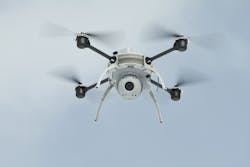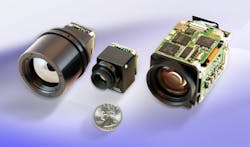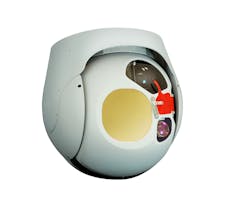DEFENSE & SECURITY: Meeting the design challenges for imaging payloads on small UAVs
CHRIS JOHNSTON
The use of robotic and remotely piloted aircraft, drones, unmanned aerial vehicles (UAVs), and unmanned aircraft systems (UAS) has recently captured the attention of the general public. There are documentaries and dramas on TV and daily articles in local newspapers about police drones. A UAS Caucus now exists in Congress, and lawmakers are eagerly rushing to propose new laws and regulations for the use of robotic aircraft in the US National Airspace System (NAS). And Congress passed the latest FAA Reauthorization with language instructing regulators to integrate unmanned aircraft in the NAS.
The accelerated adoption of unmanned aircraft has occurred over the past decade during America's military engagements overseas. The expansion of missions and attention paid to these systems has been dramatic; however, as defense budgets for these systems decrease, nondefense applications of these systems will increase.
For defense requirements, unmanned aircraft have primarily provided an overhead video asset for the military. The primary application of these systems has been to loft cameras overhead to give military decision makers a bird's-eye view of a particular mission. The most attention-grabbing application has extended this function to intelligence, surveillance, and reconnaissance (ISR), as well as targeting. As defense requirements decrease, it's important to understand some predicted future nondefense applications—and the payload challenges for these missions.
Small unmanned airborne systems
While large, expensive systems have garnered the most attention with military use, these systems have not been commercially integrated into the NAS. The language of the FAA Reauthorization describes several NAS integration milestones, but it is unclear what kind of robotic airplanes will ultimately be flying overhead.
Between now and 2015, the FAA language states that the maximum takeoff weight will be 4.4 lb, and by agreement, there is authorization to apply for a Certificate of Authorization (COA) to operate an unmanned system that weighs less than 25 lb. Additionally, only public agencies such as police or universities may apply for a UAS COA under current rules. Consequently, future missions for unmanned airborne systems in the US will most likely be relatively small, inexpensive systems with attendant small payloads onboard.
Currently, there are few unmanned aircraft in use in defense applications that could qualify for full authorization to operate in the NAS without special permission. The available aircraft that meet the 4.4 lb limit, the 25 lb limit, or the 55 lb FAA definition of a small UAS (and their payload-carrying capability) presents challenging design limitations for the payload engineer. The starting point for any payload on a small UAS is the mass limit. Close behind is the mission duration.
One can design a relatively heavy, highly capable payload that can be lifted off the ground by a small UAS, but if the aircraft's energy budget is spent in 6 min, not much is gained. There is usually a direct tradeoff between payload mass and mission duration. If a long-duration mission is needed from a 4.4 lb aircraft, then strong batteries and a feather-light payload are required.
Considering the requirement of overhead video for mission situational awareness, a 4.4 lb aircraft, line-of-sight operation (as mandated by FAA), and 20 min mission duration, the payload mass will be approximately 200–250 g, or approximately 0.5 lb. Most of the aircraft in this weight class are multi-rotorcraft (see Fig. 1). Such a payload would need only articulation in tilt, with the pan function provided by the yaw motion of the aircraft.
The next requirement is to consider whether the application is for daylight and/or night operation. If the mission is day-only, it's easy to envision a payload with a small block-style camera that would include moderate-to-narrow zoom. With operational altitudes of notionally 500 ft or less for line-of-sight control, very high-quality imagery of human-scale subjects could be obtained with such a camera.
The core mass of such a camera ranges from 85–140 g. While challenging, lightweight materials could be used to achieve a <250 g payload with tilt-only articulation. Perhaps with 50–100 more grams, two-axis articulation could be engineered. Small, <50 g electronics providing image de-jitter would improve video performance. Perhaps these 50 g electronics could provide target hold and potential target track functions.
The greatest challenge for the payload engineer is when a high zoom factor is required for the electro-optic (EO) camera. Lightweight payloads have a limited mass budget for the function of gyro-stabilization. Electronic stabilization schemes are effective but do not solve the motion blur present with small instantaneous fields of view (IFOVs). High-frequency vibrations and narrow zoom work against each other and cause blur within a pixel during a single exposure.
Digital stabilization will not solve this problem. What's more, electronic stabilization will not solve the high-frequency image blur caused by longer exposures that might be encountered in low light at dawn or dusk, or on dark, cloudy winter days.
Cameras matched to payloads
Powerful EO visible-light cameras suitable for the 4.4 lb class of cameras are readily available, which is not the case for nighttime operations and thermal imaging. Very small and compact camera cores are available, but the optical half of a system will still limit performance of a thermal imaging payload. Powerful zoom optics are readily available in the visible but are not common for small, lightweight, uncooled long-wavelength infrared (LWIR) thermal imagers.
An ideal imager would have at least two fields of view. For a given mission elevation, the wide FOV should provide a good, reasonable situational awareness plus the ability to image human-scale objects with a narrow FOV position. Many excellent cameras can perform one or the other function, but not both. An IR optic for a small, uncooled thermal camera core that can provide narrow field of view for determining human-scale intentions would drive the size and mass beyond an acceptable mass for a 250 g payload (see Fig. 2).The currently allowed public use of UAS in the NAS, where 4.4 lb machines are flown line-of-sight and below 400 ft, contrasts with the next size up in small UAS used in defense applications. There are a handful of aircraft weighing approximately 40 lb, which greatly extend UAS utility. These are fixed-wing aircraft operating at 3000–5000 ft that can carry aloft a payload weighing up to 7–8 lb. Such a payload can carry more powerful EO imagers with even greater zoom capability, and more important, compact, cooled mid-wavelength infrared (MWIR) imagers with powerful zoom for effective nighttime imaging.
These UAS fly orbits over mission zones 50 or 60 km from a ground station, operate for 10–20 hr for continuous mission coverage, and carry powerful payloads that transmit full motion video to remote ground stations. These fixed-wing aircraft systems are able to quickly switch between the wide situational awareness mission and the narrow-FOV human-scale object assessment.
Conceivably future civilian use of such UAS would assist or augment first responders. This class of UAS is generally less expensive per hour than manned rotary aircraft, and can deploy for many hours at a time without refueling. Should industry and regulators continue the work necessary to integrate this class of small UAS, more overhead assets could be deployed more cost-effectively. The deployable mission payloads would be greatly increased as well. In addition to reasonable EO/IR surveillance payloads, communications relay and other surveillance assets can be deployed for hours at a time, at wide-ranging distances from the control station and for low hourly costs.
Precision, four-axis stabilized imaging payloads weighing 7–8 lb and employing powerful EO and MWIR imagers would easily be able to image human-scale objects at very low cost per operating hour. This intermediate-sized payload would have a very powerful EO imager with continuous zoom to very narrow FOV, a similar cooled MWIR imager, and video and payload processing electronics that allow for image enhancement, tracking, picture-in-picture display, and numerous other functions. Current EO systems offer human recognition from 4200 ft slant ranges, and the best IR imagers can identify human-scale intentions at night from undetectable elevations and slant ranges (see Fig. 4).With narrow fields of view, the challenge of image stabilization becomes critical. With disturbance frequency ranges from 0.1 to 100 Hz, these disturbances, when "looking down the soda straw," would render the imager useless without precision stabilization. The less a pixel-on-target moves in response to an aircraft being buffeted by winds or because of motor vibrations transmitted from the aircraft into line-of-sight motion, the higher the quality of video.
The first level of stabilization can be achieved moderately well with two-axis systems and very high-frequency gyros and electronics. The next level in stabilization technology is the four- or five-axis systems with inner inertial stabilization. This technology is found the 50-200 lb class turrets flown on large manned aircraft, and on a few <15 lb payloads flown on small UAS. For future civil UAS, one can expect innovations in sensors, materials, and optics targeted toward the payloads in the <250 g class suitable for the 4.4 lb aircraft. Should the FAA allow the small <55 lb class of UAS to operate in the NAS, there will be greater development in the <4 kg class of payload as well.
Chris Johnston is vice president of sales and marketing, Infrared Projects, HoodTech Vision, 3100 Cascade Ave., Hood River, OR; e-mail [email protected]; www.hoodtech.com.



